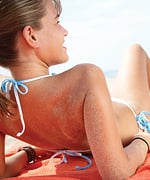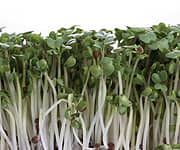Life Extension Magazine®
Years of daily exposure to ultraviolet radiation from the sun take their toll on your skin. Sun-damaged skin becomes dry and rough, uneven patches and dark spots begin to appear, fine lines and wrinkles deepen, and your skin loses its firmness and elasticity. And, if you spent any part of your youth sunbathing you may find that your skin looks years older than you feel. Scientific research has led to the discovery of natural compounds that can help support the structure of skin as well as minimize signs of aging, such as crow’s feet, lines, sagging, and uneven tone. Many of these natural compounds come from the foods we eat. Dermatological research increasingly focuses on the value of topical application of concentrated extracts of nutrient-rich foods! Some examples are leafy green vegetables and cruciferous vegetables such as cabbage, kale, and broccoli, which provide many internal health benefits. What you may not know is that key phytonutrients in these vegetables can also visibly improve the health and appearance of your skin. Concentrated extracts from cruciferous vegetables like broccoli contain bioactive phytonutrients that can help to reverse and repair a lifetime of skin damage1—revealing smoother, clearer, and more radiant skin. Naturally Occurring Compounds Provide Powerful Protection for Your Skin
Young broccoli from freshly sprouted seeds is particularly rich in a compound called glucoraphanin.2 Glucoraphanin and other phytonutrients play a vital role in cancer prevention, immune system function, and the maintenance of healthy, youthful skin. Broccoli sprouts, the youngest broccoli plants, first made the news in the late 1990s when researchers at the Johns Hopkins School of Medicine found that glucoraphanin, a potent anti-cancer compound, was highly concentrated in them.3 While the fully-grown broccoli stalks and florets we buy at the grocery store contain a biologically significant amount of glucoraphanin, the tender, three-day old broccoli sprouts are naturally packed with as much as 100 times more glucoraphanin by weight.3 Broccoli Sprouts are Bursting with PhytonutrientsWhen broccoli sprout cells break open—which happens when the plant is damaged or eaten—glucoraphanin is released and mixes with a naturally occurring companion enzyme called myrosinase.3 When these two compounds meet, they form a new substance called sulforaphane. Sulforaphane has demonstrated a wide range of health benefits. It supports your skin’s ability to detoxify, inhibits bacterial growth, has anticancer activity, and provides powerful protection against damage caused by UV radiation.4-7 It acts by stimulating production of enzymes (including glutathione S-transferase in the skin) that boost its ability to defend against sun damage8—the UV rays that cause your skin to wrinkle and age prematurely. Applied topically to the skin, concentrated broccoli sprout extract helps to minimize inflammatory processes, which can diminish redness, puffiness, and irritation, and improve the appearance, tone, and texture of your skin.1 In addition to protecting against—and even reversing—the appearance of sun-damaged skin, sulforapahane offers protection against the UV-induced oxidative damage that can lead to skin cancer.9-11 Broccoli sprouts also contain a variety of antioxidants, including beta-carotene, a naturally occurring form of vitamin A that can be enzymatically converted to retinol. Healthy human skin contains beta-carotene and the enzymes to convert it to other retinoid compounds.12 Retinol and synthetic forms of vitamin A such as tretinoin are often included in anti-aging skin care treatments because retinol has potent anti-wrinkle activity—reversing even coarse wrinkling and improving the appearance of sun-damaged skin.13 One disadvantage of the use of synthetic tretinoin is that for many people, especially those with sensitive skin, it irritates the skin, causing it to become reddened and inflamed.14 In contrast, naturally occurring beta-carotene, can be converted to retinol in the body, yet it does not cause irritation, redness or other unpleasant side effects. In addition to antioxidant activity, beta-carotene stimulates collagen production, which helps to smooth wrinkles and maintain tighter and suppler skin. It also boosts the elasticity and resilience of the skin and calms ruddy complexions, evening skin tone.15 The synergistic effect of these phytonutrients can help to support and protect the skin, enabling it to perform its most important function—serving as the first line of defense against environmental toxins, microbial pathogens and other harmful influences. These phytonutrients can also effectively counter the effects of environmental stress on your skin, enabling your skin to look and feel healthy and rejuvenated.
Antioxidants Join Forces to Combat Signs of AgingBecause antioxidants interact synergistically,16 researchers have combined the phytonutrients derived from broccoli sprouts with the bioactive polyphenols contained in red and green tea. The result increases the antioxidant quotient of skin revitalizing and restoring compounds. Like other teas, red tea contains a host of bioflavonoids, it is the only natural source of aspalthin, a potent free radical scavenger that has been used to treat inflammation of the skin.17 The antioxidant activity of the flavonoids in red tea has been studied and aspalthin has been shown to be an effective inhibitor of cellular damage brought on by oxidative stress.18,19 Red tea is not the only tea with special benefits for the skin. Antioxidant rich green tea adds to the anti-aging and anti-inflammatory effects of sulforaphane and beta-carotene. Epigallocatechin-3-gallate is the principal antioxidant polyphenol in green tea and in addition to its antioxidant activity, it also demonstrates photoprotective, anti-inflammatory, and anti-angiogenic20 (inhibits the growth of new blood vessels) properties, which may help to reduce the appearance of small, dilated blood vessels around the nose, cheek, and chin. The polyphenols in green tea have also been shown to increase the tensile strength of skin and enhance wound healing.21 In combination, these potent antioxidants can not only improve skin health and reverse the signs of aging in photodamaged skin but also help to prevent future damage from free radicals and ultraviolet radiation.22
SummaryGlucoraphanin, which is abundant in fresh broccoli sprouts, can protect your skin from damage caused by ultraviolet radiation. Applied to the skin, concentrated broccoli sprout extract soothes inflammation, and diminishes redness, swelling, and irritation, improving the look, tone, and texture of your skin. In addition to protecting against—and even reversing—the appearance of sun-damaged skin, sulforapahane offers protection against the UV-induced oxidative damage that can lead to skin cancer. If you have any questions on the scientific content of this article, please call a Life Extension® Health Advisor at 1-866-864-3027. | ||||||||
| References | ||||||||
| 1. Kawachi Y, Xu X, Taguchi S, et al. Attenuation of UVB-induced sunburn reaction and oxidative DNA damage with no alterations in UVB-induced skin carcinogenesis in Nrf2 gene-deficient mice. J Invest Dermatol. 2008 Jul;128(7):1773-9. 2. Gu Y, Guo Q, Zhang L, Chen Z, Han Y, Gu Z. Physiological and biochemical metabolism of germinating broccoli seeds and sprouts. J Agric Food Chem. 2012 Jan 11;60(1):209-13. 3. Fahey JW, Zhang Y, Talalay P. Broccoli sprouts: an exceptionally rich source of inducers of enzymes that protect against chemical carcinogens. Proc Natl Acad Sci U S A. 1997 Sep 16;94(19): 10367-72. 4. Saw CL, Huang MT, Liu Y, James DR. Induction of phase 2 antioxidant enzymes by broccoli sulforaphane: perspectives in maintaining the antioxidant activity of vitamins A, C, and E. Front Genet. 2012;3:7. 5. Haristoy X, Fahey JW, Scholtus I, Lozniewski A. Evaluation of the antimicrobial effects of several isothiocyanates on Helicobacter pylori. Planta Med. 2005 Apr;71(4):326-30. 6. Rushworth SA, Micheau O. Molecular crosstalk between TRAIL and natural antioxidants in the treatment of cancer. Br J Pharmacol. 2009 Aug;157(7):1186-8. 7. Saw CL, Huang MT, Liu Y, Khor TO, Conney AH, Kong AN. Impact of Nrf2 on UVB-induced skin inflammation/photoprotection and photoprotective effect of sulforaphane. Mol Carcinog. 2011 Jun;50(6):479-86. 8. Jariashvili K, Madhan B, Brodsky BTalalay P, Mannervik B. Isothiocyanates as substrates for human glutathione transferases: structure-activity studies. Biochem J. 1995 Oct 15;311( Pt 2):453-9. 9. Dinkova-Kostova AT, Jenkins SN, Fahey JW, et al. Protection against UV-light-induced skin carcinogenesis in SKH-1 high-risk mice by sulforaphane-containing broccoli sprout extracts. Cancer Lett. 2006 Aug 28;240(2):243-52. 10. Dinkova-Kostova AT, Fahey JW, Wade KL, et al. Induction of the phase 2 response in mouse and human skin by sulforaphane-containing broccoli sprout extracts. Cancer Epidemiol Biomarkers Prev. 2007 Apr;16(4):847-51. 11. Talalay P, Fahey JW, Healy ZR, et al. Sulforaphane mobilizes cellular defenses that protect skin against damage by UV radiation. Proc Natl Acad Sci U S A. 2007 Oct 30;104(44):17500-5. 12. Antille C. Topical beta-carotene is converted to retinyl esters in human skin ex vivo and mouse skin in vivo. Exp Dermatol. 2004 Sep;13(9):558-61 13. Samuel M, Brooke RC, Hollis S, Griffiths CE. Interventions for photodamaged skin. Cochrane Database Syst Rev. 2005 Jan 25;(1):CD001782. 14. Ting W. Tretinoin for the treatment of photodamaged skin. Cutis. 2010 Jul;86(1):47-52. 15. Cho S, Lee DH, Won CH, et al. Differential effects of low-dose and high-dose beta-carotene supplementation on the signs of photoaging and type I procollagen gene expression in human skin in vivo. Dermatology. 2010;221(2):160-71. 16. Heinrich U, Tronnier H, Stahl W, Béjot M, Maurette JM. Antioxidant supplements improve parameters related to skin structure in humans. Skin Pharmacol Physiol. 2006;19(4):224-31. 17. Bramati L, Minoggio M, Gardana C, Simonetti P, Mauri P, Pietta P. Quantitative characterization of flavonoid compounds in Rooibos tea (Aspalathus linearis) by LC-UV/DAD. J Agric Food Cem. 2002 Sep 25;50(20):5513-9. 18. Marnewick JL, Rautenbach F, Venter I, et al. Effects of rooibos (Aspalathus linearis) on oxidative stress and biochemical parameters in adults at risk for cardiovascular disease. J Ethnopharmacol. 2011 Jan 7;133(1):46-52. 19. Snijman PW, Joubert E, Ferreira D, et al. Antioxidant activity of the dihydrochalcones Aspalathin and Nothofagin and their corresponding flavones in relation to other Rooibos (Aspalathus linearis ) Flavonoids, Epigallocatechin Gallate, and Trolox. J Agric Food Chem. 2009 Aug 12;57(15):6678-84. 20. Domingo DS, Camouse MM, Hsia AH, et al. Anti-angiogenic effects of epigallocatechchin-3-gallate in human skin. Int J Clin Exp Pathol. 2010 Aug 5;3(7):705-9. 21. Qin Y, Wang HW, Karuppanapandian T, Kim W. Chitosan green tea polyphenol complex as a released control compound for wound healing. Chin J Traumatol. 2010 Apr 1;13(2):91-5. 22. Puizina-Ivi N, Miri L, Carija A, Karlica D, Marasovi D. Modern approach to topical treatment of aging skin. Coll Antropol. 2010 Sep;34(3):1145-53. 23. Jariashvili K, Madhan B, Brodsky B, Kuchava A, Namicheishvili L, Metreveli N. UV damage of collagen: insights from model collagen peptides. Biopolymers. 2012 Mar;97(3):189-98. 24. Norval M, Halliday GM. The consequences of UV-induced immunosuppression for human health. Photochem Photobiol. 2011 Sep-Oct;87(5):965-77. |





